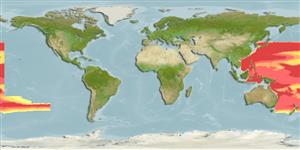Elasmobranquios (tiburones y rayas) (sharks and rays) >
Squaliformes (Sleeper and dogfish sharks) >
Etmopteridae (Lantern sharks)
Etymology: Etmopterus: Greek, ethmos, -ou = sieve or ethmoides bone + Greek, pteron = wing, fin (Ref. 45335).
More on authors: Jordan & Snyder.
Issue
Research shows that this species is restricted to northwestern Pacific ; Austral-Indonesian records are considered to represent two or three undescribed species (see Ref. 87957); distribution will be resolved (linked to correct species) when publications are received.
Environment: milieu / climate zone / depth range / distribution range
Ecología
marino; rango de profundidad 150 - 1357 m (Ref. 106604). Deep-water; 40°N - 48°S
Western Pacific: Japan to Philippines.
Length at first maturity / Tamaño / Peso / Age
Maturity: Lm ?, range 34 - ? cm
Max length : 55.0 cm TL macho / no sexado; (Ref. 122636); peso máximo publicado: 775.00 g (Ref. 122636)
Espinas dorsales (total) : 2; Espinas anales: 0. Dark grey (Ref. 6577) or brown dorsally, black ventrally, with a distinct black streak above and behind pelvic fins; fins lighter; belly luminous (Ref. 26346). Small and slender with a moderately elongate caudal peduncle and with flank denticles mostly arranged in regular rows. The base of the pelvic flank marking is under the second dorsal-fin spine, the anterior branch is usually longer than the posterior branch, and the caudal marking is considerably longer than the precaudal marking (Ref. 6871).
Found on the outer continental and insular shelves and upper slopes (Ref. 247). Its luminescent belly may attract prey (Ref. 26346), which consists mainly of squid (reported to bite squid bigger than itself), small bony fishes, and shrimps (Ref. 247). Often caught in large schools which may suggest that the luminescence may also be used to keep the group together in the dark deep ocean (Ref. 26346). Ovoviviparous (Ref. 205), size at birth about 15 cm (Ref. 6871).
Life cycle and mating behavior
Maturities | Reproducción | Spawnings | Egg(s) | Fecundities | Larva
Presumably ovoviviparous (Ref. 6871). Size at birth about 15 cm (Ref. 6871). Distinct pairing with embrace (Ref. 205).
Compagno, L.J.V., 1984. FAO Species Catalogue. Vol. 4. Sharks of the world. An annotated and illustrated catalogue of shark species known to date. Part 1 - Hexanchiformes to Lamniformes. FAO Fish. Synop. 125(4/1):1-249. Rome, FAO. (Ref. 247)
IUCN Red List Status (Ref. 130435)
Threat to humans
Harmless
Human uses
Pesquerías: sin interés
Herramientas
Special reports
Download XML
Fuentes de Internet
Estimates based on models
Preferred temperature (Ref.
123201): 6.7 - 14.6, mean 9.6 °C (based on 350 cells).
Phylogenetic diversity index (Ref.
82804): PD
50 = 0.5000 [Uniqueness, from 0.5 = low to 2.0 = high].
Bayesian length-weight: a=0.00245 (0.00163 - 0.00370), b=3.07 (2.95 - 3.19), in cm total length, based on LWR estimates for this species & Genus-body shape (Ref.
93245).
Nivel trófico (Ref.
69278): 4.2 ±0.3 se; based on diet studies.
Resiliencia (Ref.
120179): Muy bajo, población duplicada en un tiempo mínimo superior a 14 años (Fec assumed to be <10).
Fishing Vulnerability (Ref.
59153): Moderate vulnerability (42 of 100).
Nutrients (Ref.
124155): Calcium = 8.37 [1.63, 45.94] mg/100g; Iron = 0.348 [0.084, 1.304] mg/100g; Protein = 19.1 [16.5, 21.3] %; Omega3 = 0.331 [0.114, 1.053] g/100g; Selenium = 10.4 [2.6, 35.8] μg/100g; VitaminA = 31.4 [5.4, 200.3] μg/100g; Zinc = 0.478 [0.223, 0.979] mg/100g (wet weight);
